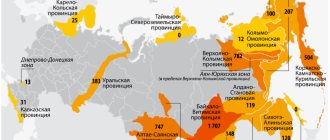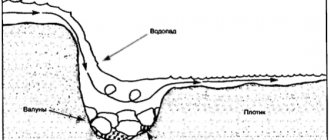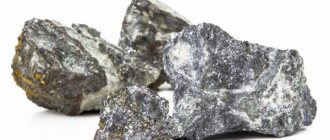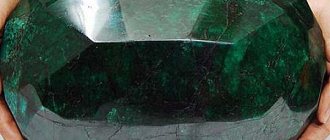List of leading countries in gold mining in the world
Among all minerals, this rock is considered one of the most valuable, which explains its importance for state reserves - with the help of gold, the liquidity of the national currency is determined.
Indonesia
On average, about 110 tons of ore are mined per year. There are more prospects for production, but the country has an active tax amnesty program, which was introduced to attract investment, but in fact hinders gold mining companies within Indonesia.
Ganga
The state is located in northern Africa. Development here began in the 15th century by Europeans. The abundance of mines led to the fact that deep reserves were not used for many years - ore was collected on the surface.
Despite the fact that there are a large number of gold-bearing sources in the Ganges, they are not developed on an industrial scale, but by small private entrepreneurs with primitive mining methods. The gold is crushed along with other rocks and washed away.
However, such methods also yield at least 130 tons per year.
Mexico
The geological stop is extremely favorable. The subsoil of this territory gives residents not only gold, but also other precious metals and stones. Production does not fall below 120 tons, which is considered a very good indicator and allows the country to remain among the leaders in gold mining. This is due to the volcanic soil, rich in resources. Each ore (including lead, silver) is subjected to modern beneficiation technology, which makes production more cost-effective.
Canada
Annual production exceeds 160-170 tons. In 2021, a new gold-bearing source was developed, which gives the country certain prospects. Although the state is among the top ten in production, it is considered to have unfavorable economic policies. Canada's decision to sell its gold reserves caused widespread resonance. This move was explained by two factors:
- Gold does not earn interest.
- Storing large volumes of ore requires too much space.
South Africa
The country in southern Africa was so caught up in the gold rush that in 1970, under the leadership of the British Empire, a record amount of metal was mined here - more than 1,000 tons. But the results for 2021 give a disappointing picture: the results are 18% lower than 2017. The same statistics are provided by experts on other precious metals and rocks.
Peru
Most Peruvians are employed in industries where gold, copper and other resources are mined. This developed area is explained by the ease of extraction - gold particles are found in rivers and lakes on the west coast of South America. Due to the lack of modern technology, the level of gold production is not actually growing, which makes the country less competitive than other leaders.
USA
In the 19th century, one could talk about the undoubted primacy of the country, but gradually it began to lose to South America and Russia. Today, the United States occupies an honorable 4th place among the leaders. 230-240 tons is a stable production level. The government and economic representatives announce a policy of reducing gold mining in connection with maintaining its national currency, the dollar, at the same level. This leads to the closure of a number of mines.
Australia
Half of the state's exports are natural resources, but the gold mining system is not sufficiently funded by the state. Experts suggest Australia's position will worsen over the next 40 years. Already, the country is not increasing its rock production, but is limited to a stable figure of 288-289 tons.
This is explained by the fact that not all mines are state owned. The government gives the right to develop deposits to private individuals. Any person can get a license, even those without citizenship, that is, a tourist.
Russia
In the Russian Federation there are many deposits in 15 federal districts, the leaders among them are the Chukotka District, the Krasnodar Territory and the Amur Region. The country is heading towards increasing gold production, and the government’s interest in this program is understandable, since two-thirds of all raw materials are purchased by state-owned companies.
The breakthrough that raised Russia to the top positions of the ranking was made due to the discovery of new promising deposits in the Magadan region and Kamchatka. The cold climate makes gold mining difficult.
China
China's gold mining policy is multilateral. Various methods are actively used:
- A lot of gold is mined - about 450 tons per year, while the latest technologies are used, old mines are modernized and new ones are built.
- The country takes part in gold mining projects of other countries, including joint projects with Russia.
- On the gold market, representatives of China are buying bullions of the precious metal.
These steps are determined by the desire to strengthen the position of the yuan in the world.
How much was produced?
Gold mining as a phenomenon started after ancient tribes gave this metal a special status. This happened because the small pieces found on the river banks amazed with their unusual brilliance and beauty.
The process of gold mining became meaningful and technologically targeted in the Copper Age. Approximately 6 thousand years ago, the first mines were established in Egypt. The oldest deposit on Earth was discovered in Nubia, between the Nile bed and the Red Sea. The first miners did this by thoroughly washing the gold-bearing sands through a cloth. The ancient Egyptian deposit turned out to be very large, and over the entire history of its existence it produced about 6 thousand tons of precious metal.
A little later, the technology improved, and after a couple of centuries it became possible to separate the ore from the general rock. In Ancient Rome, they successfully solved the problem of processing large volumes of rocks. To do this, they dug long tunnels, which were strengthened from the inside with supports. When the tunnel was ready, the supports were removed. Huge layers of ore crumbled, after which they were washed in a crushed state and the treasured ingots were found.
Then, for a long period, progress in this industry froze at one level, and a new round began only in the 19th century, when production was supplemented by the hydraulic method. The ingots mined in this way were of better quality, and the process itself became less dangerous and labor-intensive.
As for how much of this precious metal is currently mined in the world, experts dealing with this issue can only give an approximate figure.
It is believed that out of all the deposits on earth in the entire history of mankind, about 160 thousand tons were found and extracted. This figure sounds much more impressive than such a volume actually looks like. Aurum is a metal with a high molecular weight, which is why its weight is quite large. If the entire extracted volume were melted into a single cube, it would easily fit on a standard tennis court, and would also leave 2 meters unoccupied.
Which country comes first?
Useful articles
Gold rate for today: online quotes chart + analytics and forecast
Russia's gold and foreign exchange reserves today: is there any cause for concern?
Investments in metals: is it really profitable to invest in gold?
For several years now, the undoubted leader has been China. About 15% of all ore in the world is mined here. This is explained both by politics and the desire to strengthen the currency, and by favorable rock development, new mines. Experts predict the country’s leading position for at least another 15 years.
LiveInternetLiveInternet
Gold is one of the most precious metals in the world, not only because of its sublime beauty, but also because of its outstanding shelf life and ability to conduct electricity. Gold mining occurs around the world, with 90 countries currently mining the expensive metal, but 20 of them have deposits that are so rich that they manage to cover approximately 75% of the world's production. In this collection, you'll learn about the 10 countries with the largest gold reserves in the world to get a better picture of the vast wealth that can be found in their mines. Ghana
Ghana is a sovereign African nation that has abundant gold reserves of approximately 1,600 tons. However, the country's official gold assets amount to approximately 8.7 tons, which make up 8.4% of its gold and foreign exchange reserves. Gold mining has always been popular in Ghana, especially between 2011 and 2012 when production increased by 17%. Naturally, this increase in production coincided with an increase in the price of gold, but it is difficult to expect further increases in the near future, especially given the current global economy. Uzbekistan
Even though Uzbekistan has not reported its official gold assets, its state Geological Committee has announced that the country owns more than 40 deposits with a total estimated reserve of approximately 1,700 tons. This is a lot of gold, which is quite difficult to mine. But fortunately, Uzbekistan has major gold mining companies that plan to mine approximately 120 tons per year. The largest and most important producers in Uzbekistan are the Metallurgical Plant and the Navoi Mine, which develop gold deposits worth $500 billion.
Indonesia
When a country goes through a political crisis, its level of industrial production tends to shrink. This is exactly what happened recently to Indonesia's gold mining sector. Many development projects were stopped due to illegal gold mining, which caused the country to lose even more money. However, Indonesia's gold reserves are approximately 3,000 tons, which is quite an impressive figure. The country's official gold holdings stand at 73.1 tonnes, which is definitely not small.
Canada
Canada is no longer the gold mining giant it once was, and the country's gold assets now stand at just 3.4 tonnes. However, a Canadian company called Barrick Gold had the highest production level of gold of any company of its kind, reaching 7.42 million ounces.
Peru
Peru's official gold assets are 34.7 tons, while gold deposits are estimated to be around 170 tons. Even though the country's gold production fell by approximately 3% in 2012, Peru still has one of the world's most impressive gold production records, which earned the country its place on this list.
South
Africa South Africa has not done well in gold mining in recent years, with 2012 being the second worst year since the 1905 gold mine strike. Because of this, South African gold represented only 6% of the world's total production at the time. However, South Africa's 125 tonnes of gold assets are nothing to be ashamed of, not to mention the fact that South Africa is home to the third largest gold mining company in the world, AngloGold Ashanti, which is based in Johannesburg.
Russia
Russia is the first major player in this list of countries with the largest gold reserves in the world, as its reserves are no less than 937.8 tons of gold. Moreover, total Russian gold reserves are estimated at approximately 5,000 tons, while the country's gold production increased by 6.8% in 2012.
States The
United States is home to one of the world's top gold producers, Newmont Mining, which reported producing 4.98 million ounces of gold in 2012. If that isn't impressive enough for some, the United States has the largest official gold assets in the world: 8,133.5 tons, accounting for 76.3% of the country's foreign currency. A very impressive figure!
Australia
Australia is currently the second largest gold producer in the world. Its main mines are located in New South Wales, in its southern and western regions. Australia announced that its official gold holdings amount to 79.9 tonnes, while the entire continent's reserves are estimated at approximately 7,400 tonnes. Two thirds of all gold production in the world occurs in Western Australian mines.
China
Finally, the largest reserves of gold, as well as the highest level of production, are observed in China, which is not surprising, since this country is one of the most economically advanced. In 2012, China led world gold production for the sixth year in a row, while its gold production increased by 11.7% during the same year. Since 2003, China has doubled its production capacity, which should help it become the world's leading economy. The largest gold producer in the country is definitely Zijin Mining Company, which reported production of 2,770,428 ounces of gold in 2011. China holds a total of 1,054.1 tons of gold, while its production is 403 tons.
source











